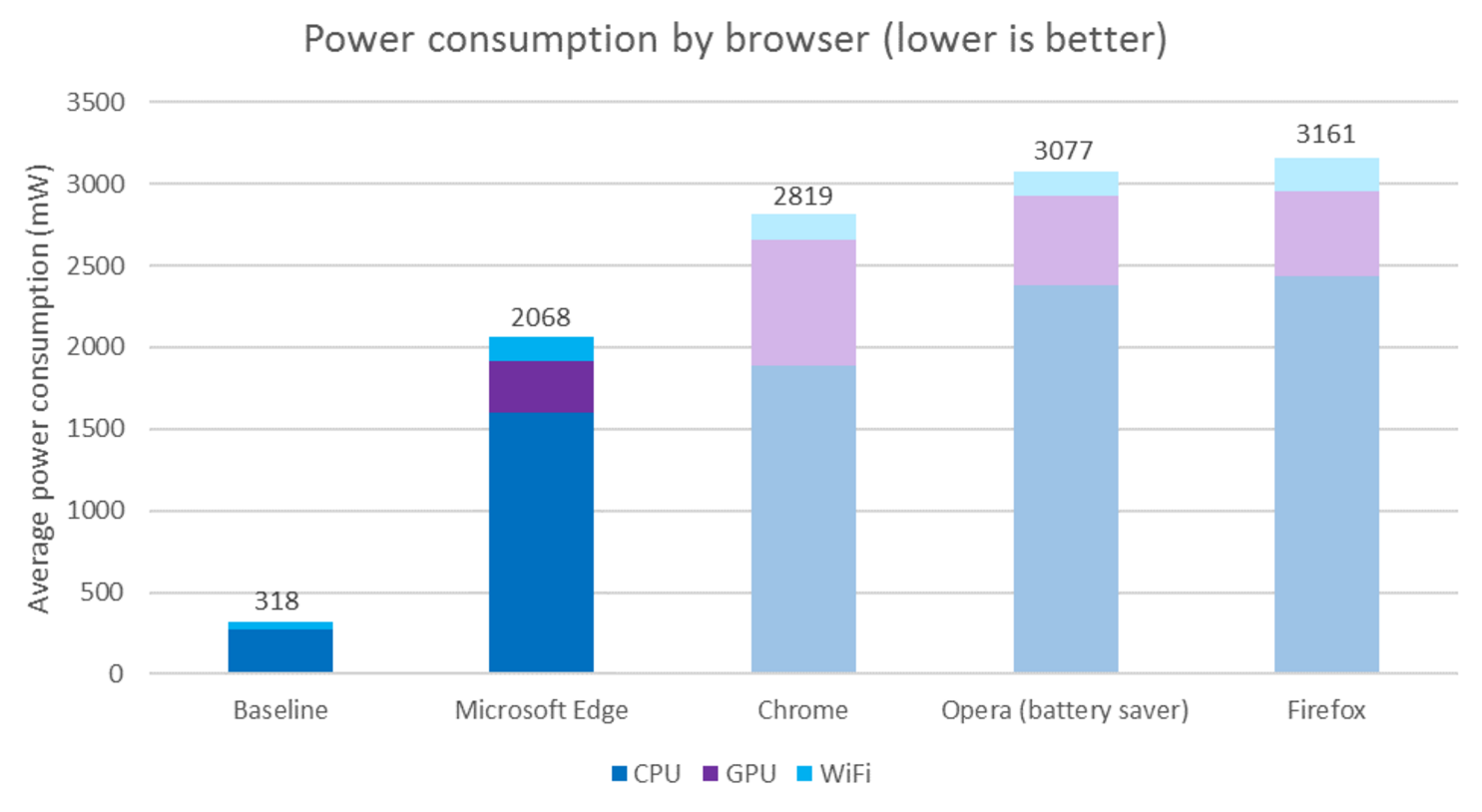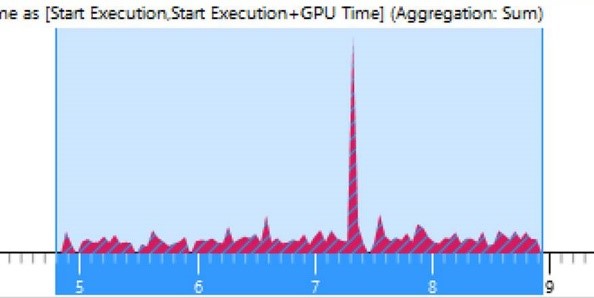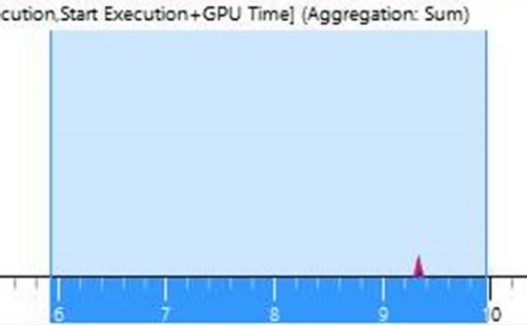Microsoft: Edge bypasses all major browsers for energy efficiency
Microsoft claims that the Edge browser built into Windows 10 consumes less power than other popular browsers like Mozilla Firefox, Google Chrome and Opera. Lab results show energy efficiency Edge. Also, this is confirmed by statistics - Windows 10 is installed on several hundred million devices, which provides a rich base for collecting telemetry.
For eight months, Windows 10 showed the most successful start in the history of the operating system family. According to March data , it is used on 270 million active devices. This is helped not only by the free upgrade, but also by the aggressive policy of its promotion. Once again, to show how good the new operating system is, Microsoft compared the Edge browser's energy efficiency with other popular browsers.
In a blog, Microsoft recalls that the Edge browser was originally designed to maximize the potential of devices with minimal use of resources. The company decided to test empirically whether this task was accomplished, and connected several devices to wattmeters. For the test, we chose Surface Pro 3, Surface Pro 4, and Surface Book.
')

On each device, experts automated the standard work in one of the popular browsers. Actions included opening sites, scrolling articles, watching videos, opening new tabs for each task. The devices "walked" on the usual resources for people - Facebook, Google, YouTube, Amazon, Wikipedia and others. The diagram below shows the average power consumption for identical tasks in milliwatts.

In laboratory experiments, the Edge computer runs 36-53% longer on a single battery charge compared to samples from other browsers.
In addition to the Surface devices, the Microsoft laboratory tested the energy efficiency of browsers on desktops, laptops, tablets and other gadgets.

Microsoft Power Consumption Lab
The statistics from the real world also helped to answer the question about energy efficiency. Under Windows 10, hundreds of millions of devices work, and many of them regularly send telemetry, the bounty of which is criticized by those concerned with privacy issues. Service Energy Estimation Engine on all devices with Windows 10 monitors the power consumption of iron and applications. Aggregation of data confirmed the results of the first experiment.

After two experiments, Microsoft had to visually show the low power consumption of the Edge to ordinary users. Therefore, marketers put four Surface Books with Microsoft Edge, Google Chrome, Mozilla Firefox and Opera alongside and played high-resolution video over Wi-Fi, until the battery sits down. All this was presented in the form of time-lapse video (posted before the kata).
Microsoft does not want to stop there. With the update of Windows 10 Anniversary Update, the browser will receive a number of new features .
First, Edge will slow down the work of JavaScript in tabs that are not visible to the user. Pages that check email every second or show new ads will not load the processor, although they will continue to receive data in the background - and then they will quickly exit this mode. This strategy will reduce energy consumption by up to 90% in some scenarios.

Comparison of the load on the processor in the current version of Windows 10 and Anniversary Update. In the background tabs open some eight popular sites.
Secondly, Flash will work inside a separate process, and videos will not be enabled by default. This will allow better control of its operation and reduce the load on the processor and video accelerator by disconnecting unnecessary elements. If Flash “falls”, the work will not be interrupted.
Thirdly, even processing any button can reduce power consumption. For example, the read mode button consists of 120 frames. With the availability of the opportunity to go into reading mode, the book on the icon scrolls through the pages. Each time, the XAML animation is loaded, the graphics are redrawn.

Developers removed 40% of the frames, because the visual frames at the beginning and end of the cycles did not differ. Instead of XAML, animation is used on the video accelerator, without using the processor. These and other improvements have reduced the load on the graphics accelerator by 75%, on the processor - by 100%.
Before:

After:

In order to save every milwatt, many other interface elements are being redrawn.
Finally, in Windows 10 there are a number of changes in working with the network: TCP Fast Open, Tail Loss Probe, and Recent Acknowledgment functions, and the Initial Congestion Window is optimized in the TCP stack. Due to this, in the new version of Windows 10, the Edge browser should work longer from a single charge.
Anniversary Update is timed to coincide with one year since the release of Windows 10. It is expected that the “Anniversary Update” will be released in the summer of 2016 — possibly July 16th. The exact date is still unknown. A number of changes Anniversary Update is already available under the program Windows Insider.
For eight months, Windows 10 showed the most successful start in the history of the operating system family. According to March data , it is used on 270 million active devices. This is helped not only by the free upgrade, but also by the aggressive policy of its promotion. Once again, to show how good the new operating system is, Microsoft compared the Edge browser's energy efficiency with other popular browsers.
In a blog, Microsoft recalls that the Edge browser was originally designed to maximize the potential of devices with minimal use of resources. The company decided to test empirically whether this task was accomplished, and connected several devices to wattmeters. For the test, we chose Surface Pro 3, Surface Pro 4, and Surface Book.
')

On each device, experts automated the standard work in one of the popular browsers. Actions included opening sites, scrolling articles, watching videos, opening new tabs for each task. The devices "walked" on the usual resources for people - Facebook, Google, YouTube, Amazon, Wikipedia and others. The diagram below shows the average power consumption for identical tasks in milliwatts.

In laboratory experiments, the Edge computer runs 36-53% longer on a single battery charge compared to samples from other browsers.
In addition to the Surface devices, the Microsoft laboratory tested the energy efficiency of browsers on desktops, laptops, tablets and other gadgets.

Microsoft Power Consumption Lab
The statistics from the real world also helped to answer the question about energy efficiency. Under Windows 10, hundreds of millions of devices work, and many of them regularly send telemetry, the bounty of which is criticized by those concerned with privacy issues. Service Energy Estimation Engine on all devices with Windows 10 monitors the power consumption of iron and applications. Aggregation of data confirmed the results of the first experiment.

After two experiments, Microsoft had to visually show the low power consumption of the Edge to ordinary users. Therefore, marketers put four Surface Books with Microsoft Edge, Google Chrome, Mozilla Firefox and Opera alongside and played high-resolution video over Wi-Fi, until the battery sits down. All this was presented in the form of time-lapse video (posted before the kata).
Microsoft does not want to stop there. With the update of Windows 10 Anniversary Update, the browser will receive a number of new features .
First, Edge will slow down the work of JavaScript in tabs that are not visible to the user. Pages that check email every second or show new ads will not load the processor, although they will continue to receive data in the background - and then they will quickly exit this mode. This strategy will reduce energy consumption by up to 90% in some scenarios.

Comparison of the load on the processor in the current version of Windows 10 and Anniversary Update. In the background tabs open some eight popular sites.
Secondly, Flash will work inside a separate process, and videos will not be enabled by default. This will allow better control of its operation and reduce the load on the processor and video accelerator by disconnecting unnecessary elements. If Flash “falls”, the work will not be interrupted.
Thirdly, even processing any button can reduce power consumption. For example, the read mode button consists of 120 frames. With the availability of the opportunity to go into reading mode, the book on the icon scrolls through the pages. Each time, the XAML animation is loaded, the graphics are redrawn.

Developers removed 40% of the frames, because the visual frames at the beginning and end of the cycles did not differ. Instead of XAML, animation is used on the video accelerator, without using the processor. These and other improvements have reduced the load on the graphics accelerator by 75%, on the processor - by 100%.
Before:

After:

In order to save every milwatt, many other interface elements are being redrawn.
Finally, in Windows 10 there are a number of changes in working with the network: TCP Fast Open, Tail Loss Probe, and Recent Acknowledgment functions, and the Initial Congestion Window is optimized in the TCP stack. Due to this, in the new version of Windows 10, the Edge browser should work longer from a single charge.
Anniversary Update is timed to coincide with one year since the release of Windows 10. It is expected that the “Anniversary Update” will be released in the summer of 2016 — possibly July 16th. The exact date is still unknown. A number of changes Anniversary Update is already available under the program Windows Insider.
Source: https://habr.com/ru/post/395215/
All Articles